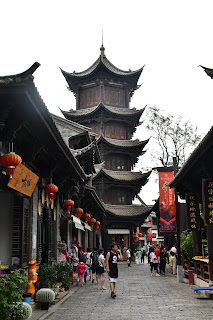There is no War in Ba Sing Se
Last week
we filled out an evaluation form about CET’s summer programme. Based on
subsequent classes, I gather my pleas to be provided with more English
translations were not heard out. Nevertheless, I maintain my pedagogically
inexpert opinion that translating a word instead of explaining it in the source
language leads to fewer misunderstandings. A plea that was heard out, however,
and to the great bewilderment of many, was to have fewer exams. Now I don’t particularly
enjoy exams myself, but having to memorise three hundred words for one exam
does not strike me as substantially more pleasant than memorising one hundred
and fifty for two.
In any
case, the exam for this week was called off and instead, all classes made a
trip to the so-called “Nationalities Village” of Yunnan. The premise of this
megalomaniacal – and really rather insultingly reductive Disneyland of sorts –
is to gather the twenty-plus officially recognised ethnic minorities of Yunnan,
strip them to their basics, and showcase their culture to tourists. Really, it
is a zoo, but with people instead of animals (though to the Village’s credit,
it must be said that at least these people are paid). Visitors get to eat
various cuisines, see members of ethnic minorities perform their dances and
songs, and leave the place with little more understanding of these cultures
than “oh this is quaint.” The whitewashed information boards, which serve to
give tourists the basics while cementing these cultures’ position within the
greater Chinese sphere, certainly do not help.
On top of that, many of the park's attractions, like a miniature of the
three pagodas of Dali, are somewhat cheesy at best. At worst, of course, they
undermine a visitor’s appreciation of real history. On the other hand, several
of the buildings seem to predate the village itself, begging the
uncomfortable question: How did they get there?
The entrance to the Ethnic Village
A replica of the three towers in Dali
The view over the lake at the Ethnic Village
My class’s
assignment for the visit was to interview a few members of ethnic minorities in
the village. Zhang Laoshi helpfully supplied us with some questions, mostly
related to concerns about preserving cultural heritage. Our inquiries went
exactly as one would expect. At the Tibetan people’s village, we were told that
Tibetan culture does not face any threats, perhaps except for the environmental
impact of tourism. Indeed, cultural exchange is very desirable. What exactly
that means, I am still not sure, but when I asked the man what he had in mind,
he told me that for example at school, children now get taught Mandarin and
English as well as Tibetan.
A Tibetan-style prayer wheel
The Tibetan Temple at the Ethnic Village
At the Hui
village, people seemed like they would rather start drawing lots than volunteer
to talk to us. When one man in his forties somewhat reluctantly agreed to
answer our questions, we got the increasingly familiar line about the
desirability of cultural exchange. As the Hui man carried on about how the
diverse Yunnanese population was one big happy family and that life was
peaceful, I could no longer contain myself and blurted out a question about
terrorist attacks in Yunnan. Admittedly this was rather ill-advised, not least
because the Hui people are Muslim, and the man at first took the question the
wrong way. True, he finally said, Muslims were regarded with some suspicion
after the attacks, but in time people will forget and everything will be all
right. As the line goes, there is no war in Ba Sing Se.
Our
excursion ended at the Zhuang village, where the workers informed us that they
were not expert enough to tell us about the impact of mainstream Chinese
culture on their own lives. I suppose in mainland China understanding one’s own
life is a field in which one must receive a university degree. All this was expected, and yet somehow, I
still left heavily dispirited.








Comments
Post a Comment